-
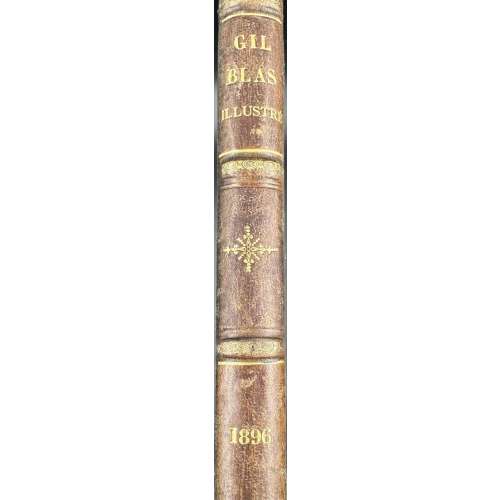 French weekly periodical, full set for the year 1896 (52 issues), 4 leaves (8 pages) each issue, bound in green half sheepskin over green shagreen, ruled with blind dentelle, raised bands, gilt floral diamonds and gilt lettering in compartments, marbled endpapers, blank flyleaves; size 405 x 280 mm. Illustrated mainly by Théophile Alexandre Steinlen (French, 1859 – 1923), Paul Balluriau [Jean-Baptiste Balluriau] (French, 1860 – 1917) and Albert Guillaume (French, 1873 – 1942).
French weekly periodical, full set for the year 1896 (52 issues), 4 leaves (8 pages) each issue, bound in green half sheepskin over green shagreen, ruled with blind dentelle, raised bands, gilt floral diamonds and gilt lettering in compartments, marbled endpapers, blank flyleaves; size 405 x 280 mm. Illustrated mainly by Théophile Alexandre Steinlen (French, 1859 – 1923), Paul Balluriau [Jean-Baptiste Balluriau] (French, 1860 – 1917) and Albert Guillaume (French, 1873 – 1942). -
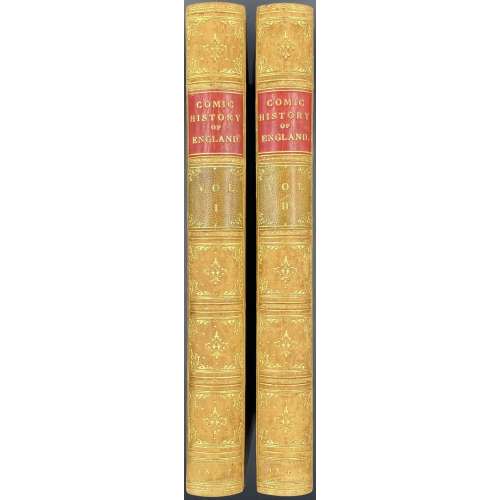 Vol. 1: Title page (red and black): THE | COMIC HISTORY OF ENGLAND • | BY GILBERT ABBOTT A'BECKETT. | {vignette with one line caption} | WITH TEN COLOURED ETCHINGS AND ONE HUNDRED AND TWENTY | WOODCUTS, | BY JOHN LEECH. | VOL. I. | PUBLISHED AT THE PUNCH OFFICE, 85, FLEET STREET. | MDCCCXLVII. || Pagination: [iii-iv] – t.p. / imprint., [v]-vi – preface, [vii]-viii – contents, [ix]-xii – list of ills. [1] 2-320, lacking half-title otherwise as called for by Tooley (1935) p. 161. Collation: 8vo; π3 b2 B-X8 plus 10 plates, incl. frontispiece, of hand-coloured steel engravings and 120 in-text woodcuts by John Leech. Vol. 2: Title page: similar but “VOL. II.” And “MDCCCXLVIII”; typeface “with ten coloured…” is different (sans serif). Pagination: [iii-iv] – t.p. / imprint., [v]-vi – advert., [vii]-viii – contents, [ix]-xii – list of ills. [1] 2-304, lacking half-title otherwise as called for by Tooley (1935) p. 161. Collation: 8vo; π3 b2 B-U8 X2 plus 10 plates, incl. frontispiece, of hand-coloured steel engravings and 120 in-text woodcuts by John Leech. Binding: two volumes 22 x 14.5 cm each uniformly bound in full tan calf with gilt double-fillet border, spine gilt in compartments with red and green morocco labels lettered in gilt, blind-stamped dentelle inside, blue marbled endpapers, all edges marbled, additional flyleafs at the front and end. Catalogue raisonné: Hardie p. 210-11; Abbey, Life № 434, p. 362; Tooley (1935) p. 161 Contributors: Gilbert Abbott à Beckett (British, 1811 – 1856) – author. John Leech (British, 1817 – 1864) – artist. Bradbury & Evans (Whitefriars); William Bradbury (British, 1799 – 1869); Frederick Mullett Evans (British, 1804 – 1870) – printer. Punch – publisher.
Vol. 1: Title page (red and black): THE | COMIC HISTORY OF ENGLAND • | BY GILBERT ABBOTT A'BECKETT. | {vignette with one line caption} | WITH TEN COLOURED ETCHINGS AND ONE HUNDRED AND TWENTY | WOODCUTS, | BY JOHN LEECH. | VOL. I. | PUBLISHED AT THE PUNCH OFFICE, 85, FLEET STREET. | MDCCCXLVII. || Pagination: [iii-iv] – t.p. / imprint., [v]-vi – preface, [vii]-viii – contents, [ix]-xii – list of ills. [1] 2-320, lacking half-title otherwise as called for by Tooley (1935) p. 161. Collation: 8vo; π3 b2 B-X8 plus 10 plates, incl. frontispiece, of hand-coloured steel engravings and 120 in-text woodcuts by John Leech. Vol. 2: Title page: similar but “VOL. II.” And “MDCCCXLVIII”; typeface “with ten coloured…” is different (sans serif). Pagination: [iii-iv] – t.p. / imprint., [v]-vi – advert., [vii]-viii – contents, [ix]-xii – list of ills. [1] 2-304, lacking half-title otherwise as called for by Tooley (1935) p. 161. Collation: 8vo; π3 b2 B-U8 X2 plus 10 plates, incl. frontispiece, of hand-coloured steel engravings and 120 in-text woodcuts by John Leech. Binding: two volumes 22 x 14.5 cm each uniformly bound in full tan calf with gilt double-fillet border, spine gilt in compartments with red and green morocco labels lettered in gilt, blind-stamped dentelle inside, blue marbled endpapers, all edges marbled, additional flyleafs at the front and end. Catalogue raisonné: Hardie p. 210-11; Abbey, Life № 434, p. 362; Tooley (1935) p. 161 Contributors: Gilbert Abbott à Beckett (British, 1811 – 1856) – author. John Leech (British, 1817 – 1864) – artist. Bradbury & Evans (Whitefriars); William Bradbury (British, 1799 – 1869); Frederick Mullett Evans (British, 1804 – 1870) – printer. Punch – publisher. -
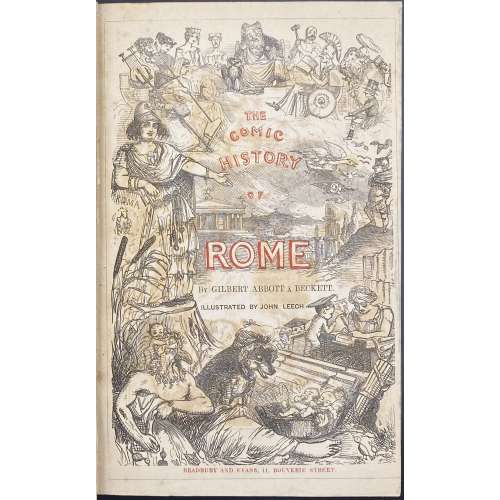 Woodcut pictorial title page (red and black): THE | COMIC | HISTORY | OF | ROME | By GILBERT ABBOTT À BECKETT. | ILLUSTRATED BY JOHN LEECH. | BRADBURY AND EVANS, 11, BOUVERIE STREET. || Pagination: [iii-iv] – t.p. / imprint., [v]-vi – preface, [vii]-viii – contents, [ix]-xii – list of ills., [1] 2-308, lacking half-title (i-ii) otherwise as called for by Tooley (1935) p. 162. Collation: π1 b4 B-U8 X2 plus 10 plates, incl. frontispiece, of hand-coloured steel engravings and 98 in-text woodcuts by John Leech. Imprint: “LONDON: | BRADBURY AND EVANS, PRINTERS, WHITEFRIARS.”; same in the colophon on p. 308, in one line. Binding: 22 x 14.5 cm, full tan calf with gilt double-fillet border, spine gilt in compartments with red morocco label lettered in gilt, blind-stamped dentelle inside, marbled endpapers, additional flyleaf at the end (binding similar to 2-volume “The Comic History of England” LIB-2847.2021, making three volumes in total). Edition: 1st thus (in book form), without “and Co.” in the imprint on t.p. verso. Catalogue raisonné: Tooley (1935) p. 162. Catalogue raisonné: Hardie p. 210; Abbey, Life № 435, p. 365-6; Tooley (1935) p. 162. Contributors: Gilbert Abbott à Beckett (British, 1811 – 1856) – author. John Leech (British, 1817 – 1864) – artist. Bradbury & Evans (Whitefriars); William Bradbury (British, 1799 – 1869); Frederick Mullett Evans (British, 1804 – 1870) – printer.
Woodcut pictorial title page (red and black): THE | COMIC | HISTORY | OF | ROME | By GILBERT ABBOTT À BECKETT. | ILLUSTRATED BY JOHN LEECH. | BRADBURY AND EVANS, 11, BOUVERIE STREET. || Pagination: [iii-iv] – t.p. / imprint., [v]-vi – preface, [vii]-viii – contents, [ix]-xii – list of ills., [1] 2-308, lacking half-title (i-ii) otherwise as called for by Tooley (1935) p. 162. Collation: π1 b4 B-U8 X2 plus 10 plates, incl. frontispiece, of hand-coloured steel engravings and 98 in-text woodcuts by John Leech. Imprint: “LONDON: | BRADBURY AND EVANS, PRINTERS, WHITEFRIARS.”; same in the colophon on p. 308, in one line. Binding: 22 x 14.5 cm, full tan calf with gilt double-fillet border, spine gilt in compartments with red morocco label lettered in gilt, blind-stamped dentelle inside, marbled endpapers, additional flyleaf at the end (binding similar to 2-volume “The Comic History of England” LIB-2847.2021, making three volumes in total). Edition: 1st thus (in book form), without “and Co.” in the imprint on t.p. verso. Catalogue raisonné: Tooley (1935) p. 162. Catalogue raisonné: Hardie p. 210; Abbey, Life № 435, p. 365-6; Tooley (1935) p. 162. Contributors: Gilbert Abbott à Beckett (British, 1811 – 1856) – author. John Leech (British, 1817 – 1864) – artist. Bradbury & Evans (Whitefriars); William Bradbury (British, 1799 – 1869); Frederick Mullett Evans (British, 1804 – 1870) – printer. -
 NEWHardcover, 184 x 122 mm, burgundy quarter shagreen over marbled boards, binding savagely restored (ex-library copy) with orange paper, handwritten title to spine in black ink with a catalogue number on top, marbled endpapers; half-title and title with library ink stamps, original wrappers not present, frontispiece: death mask of Blanqui etched by Félix Bracquemond del. et sc., imp. Porcabeuf, with protection sheet. Pp.: [2 blanks] [2 - ht/advert.] [2 - blank/frontis.] [2 - t.p. / blank] [2 - dedication/blank] 1-442, 443-4 table, 445-6 afterword by G.G., [2 blanks]. Title-page: GUSTAVE GEFFROY | — | L'ENFERME | AVEC LE MASQUE DE BLANQUI | eau-forte inédite de F. BRACQUEMOND | — | (in rules) DEUXIÈME MILLE | — | PARIS | BIBLIOTHÈQUE CHARPENTIER | EUGÈNE FASQUELLE, ÉDITEUR | 11 RUE DE GRENELLE, 11 | 1897 | Tous droits réservés || For another copy published in 1919, see LIB-3362.2024.
NEWHardcover, 184 x 122 mm, burgundy quarter shagreen over marbled boards, binding savagely restored (ex-library copy) with orange paper, handwritten title to spine in black ink with a catalogue number on top, marbled endpapers; half-title and title with library ink stamps, original wrappers not present, frontispiece: death mask of Blanqui etched by Félix Bracquemond del. et sc., imp. Porcabeuf, with protection sheet. Pp.: [2 blanks] [2 - ht/advert.] [2 - blank/frontis.] [2 - t.p. / blank] [2 - dedication/blank] 1-442, 443-4 table, 445-6 afterword by G.G., [2 blanks]. Title-page: GUSTAVE GEFFROY | — | L'ENFERME | AVEC LE MASQUE DE BLANQUI | eau-forte inédite de F. BRACQUEMOND | — | (in rules) DEUXIÈME MILLE | — | PARIS | BIBLIOTHÈQUE CHARPENTIER | EUGÈNE FASQUELLE, ÉDITEUR | 11 RUE DE GRENELLE, 11 | 1897 | Tous droits réservés || For another copy published in 1919, see LIB-3362.2024. -
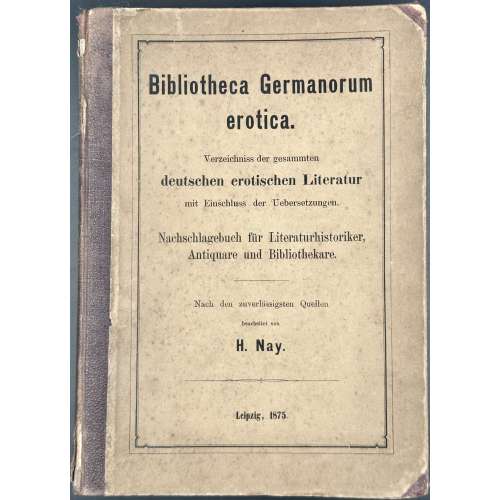 Hardcover, 231 x 165 mm, half brown cloth over cardboard, lettering in a frame to front, similar to t.p., pp.: [4] [1] 2-151 [152], collated 4to: π2 1-194, i.e. 78 leaves. Entries are in alphabetic order by name. Title-page (and front cover): Bibliotheca Germanorum | erotica. | Verzeichniss der gesammten | deutschen erotischen Literatur | mit Einschluss der Uebersetzungen. | Nachschlagebuch für Literaturhistoriker, | Antiquare und Bibliothekare. | Nach den zuverlässigsten Quellen | bearbeitet von | H. Nay. | — •— | Leipzig, 1875. || [Bibliotheca Germanorum erotica. List of all German erotic literature, including translations. Reference book for literary historians, antiquarians and librarians. Based on the most reliable sources edited by H. Nay]. Imprint: Druck von E. Rupfer in Stuttgart. Ref: Worldcat. Author: Hugo Hayn [Nay, H.] (German, 1843 – 1923)
Hardcover, 231 x 165 mm, half brown cloth over cardboard, lettering in a frame to front, similar to t.p., pp.: [4] [1] 2-151 [152], collated 4to: π2 1-194, i.e. 78 leaves. Entries are in alphabetic order by name. Title-page (and front cover): Bibliotheca Germanorum | erotica. | Verzeichniss der gesammten | deutschen erotischen Literatur | mit Einschluss der Uebersetzungen. | Nachschlagebuch für Literaturhistoriker, | Antiquare und Bibliothekare. | Nach den zuverlässigsten Quellen | bearbeitet von | H. Nay. | — •— | Leipzig, 1875. || [Bibliotheca Germanorum erotica. List of all German erotic literature, including translations. Reference book for literary historians, antiquarians and librarians. Based on the most reliable sources edited by H. Nay]. Imprint: Druck von E. Rupfer in Stuttgart. Ref: Worldcat. Author: Hugo Hayn [Nay, H.] (German, 1843 – 1923) -
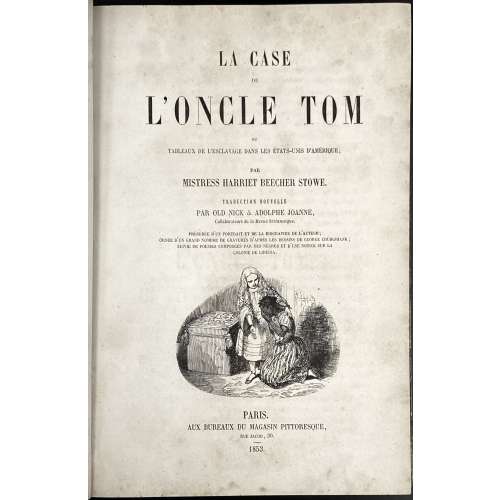 1st French edition (Paris, 1853) of Harriet Beecher Stowe's book Uncle Tom's Cabin; or, Life Among the Lowly, with 27 illustrations on wood by George Cruikshank (British, 1792 – 1878), translated into French by Paul-Émile Daurand-Forgues [pseudonym Old Nick] (French, 1813 – 1883) and Adolphe Joanne (French, 1813 – 1881). Title: LA CASE | DE | L'ONCLE TOM | OU | TABLE AUX DE L'ESCLAVAGE DANS LES ÉTATS-UNIS D'AMÉRIQUE ; | PAR MISTRESS HARRIET BEECHER STOWE. | TRADUCTION NOUVELLE | PAR OLD NICK & ADOLPHE JOANNE, | Collaboarteurs de la Revue britannique, | PRÉCÉDÉE D'UN PORTRAIT ET DE LA BIOGRAPHIE DE L'AUTEUR; | ORNÉE D'IU GRAND NOMBRE DE GRAVURES D'APRES LES DESSINS DE GEORGE CRUIKSHANK ; | SUIVIE DE POÉSIES COMPOSÉES PAR DES NÈGRES ET D'UNE NOTICE SUR LA | COLONIE DE LIBERIA. | [vignette] | PARIS. | AUX BUREAUX DU MAGASIN PITTORESQUE, | RUE JACOB, 30. | 1853. Pagination: ffl blank; [i-ii]: h.t. with stamped letters D. W. in the upper centre / imprim. to verso; [iii-iv] t.p. / blank; [v-vi] blank / frontispiece: portrait of Harriet Beecher Stowe, half-length to left, with hair in ringlets, and a shawl over shoulders, landscape behind, Henry Linton (British, 1815 – 1899) after Henry Anelay (British,1817 – 1883), wood-engraving with letterpress; [vij] Viij-xij; [1] 2-563 [564]; bfl blank; illustrations: 27 woodcuts by George Cruikshank. Collation: 8vo, π7 (1)–(35)8 363 Binding: Quarter brown calf, spine with raised bands, gilt-ruled compartments, title lettering, "D. W." in the bottom, marbled boards and endpapers. Dimensions: 24.1 x 16.4 cm. Catalogue raisonné: Albert M. Cohen (1924), №777, p. 221. "An edition was published in French with the woodcuts direct from the blocks, not, as in the English, merely from the stereotypes. The illustrations are far more impressive than those of Cassell's edition".
1st French edition (Paris, 1853) of Harriet Beecher Stowe's book Uncle Tom's Cabin; or, Life Among the Lowly, with 27 illustrations on wood by George Cruikshank (British, 1792 – 1878), translated into French by Paul-Émile Daurand-Forgues [pseudonym Old Nick] (French, 1813 – 1883) and Adolphe Joanne (French, 1813 – 1881). Title: LA CASE | DE | L'ONCLE TOM | OU | TABLE AUX DE L'ESCLAVAGE DANS LES ÉTATS-UNIS D'AMÉRIQUE ; | PAR MISTRESS HARRIET BEECHER STOWE. | TRADUCTION NOUVELLE | PAR OLD NICK & ADOLPHE JOANNE, | Collaboarteurs de la Revue britannique, | PRÉCÉDÉE D'UN PORTRAIT ET DE LA BIOGRAPHIE DE L'AUTEUR; | ORNÉE D'IU GRAND NOMBRE DE GRAVURES D'APRES LES DESSINS DE GEORGE CRUIKSHANK ; | SUIVIE DE POÉSIES COMPOSÉES PAR DES NÈGRES ET D'UNE NOTICE SUR LA | COLONIE DE LIBERIA. | [vignette] | PARIS. | AUX BUREAUX DU MAGASIN PITTORESQUE, | RUE JACOB, 30. | 1853. Pagination: ffl blank; [i-ii]: h.t. with stamped letters D. W. in the upper centre / imprim. to verso; [iii-iv] t.p. / blank; [v-vi] blank / frontispiece: portrait of Harriet Beecher Stowe, half-length to left, with hair in ringlets, and a shawl over shoulders, landscape behind, Henry Linton (British, 1815 – 1899) after Henry Anelay (British,1817 – 1883), wood-engraving with letterpress; [vij] Viij-xij; [1] 2-563 [564]; bfl blank; illustrations: 27 woodcuts by George Cruikshank. Collation: 8vo, π7 (1)–(35)8 363 Binding: Quarter brown calf, spine with raised bands, gilt-ruled compartments, title lettering, "D. W." in the bottom, marbled boards and endpapers. Dimensions: 24.1 x 16.4 cm. Catalogue raisonné: Albert M. Cohen (1924), №777, p. 221. "An edition was published in French with the woodcuts direct from the blocks, not, as in the English, merely from the stereotypes. The illustrations are far more impressive than those of Cassell's edition". -
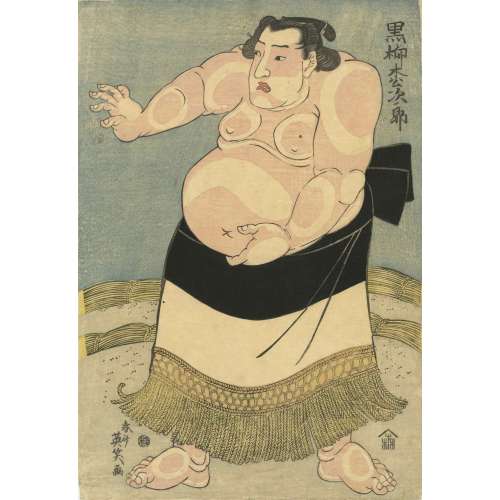 This print was sold to me with the following description: "Ikkansai EISHO (Fl. early 19th c.). A portrait of the wrestler Kuroyanagi Matsujiro, ring name Kumagatake Inosuke. Eisho was a pupil of Eishi. Published c. 1820s by Uoya Eikichi. Signed Shunsai Eisho ga." As a result of our joint effort with my beloved sister, we have so far found the following: The artis is mentioned in The Hotei Encyclopedia of Japanese Woodblock Prints, 2005, Vol 2; p. 438 under the name of Harukawa Eichō. From this source we learned that the artist was active from about 1818 till 1844, and was a print designer in Kyoto. He was a student first of Harukawa Goshichi and later studied in Edo (Tokyo) with Keisai Eisen, when he assumed the art name 'Eichō'. Other names: Shunsai. The Japanese web page dedicated to Harukawa Eichō provides more details: The artist lived from the 4th year of Tenmei ( 1784 ) to the first year of Kaei ( 1848 ). He was a student of Harukawa Goshichi, Kikukawa Eizan as well as of Keisai Eisen. His popular name was Kamenosuke. He was from Kyoto. He took "gagō" (artistic names) of Eishō when he was a student of Harukawa Goshichi; later, when he became a student of Kikukawa Eizan and Keisai Eisen he took the name of Kikukawa Eichō. The artist was mostly known for his bijinga (beautiful women) prints as well as kanazōshi illustrations. Nothing is said anywhere about his sumo prints, though the reference to another Kyushu sumo wrestler portrait has been found. The sumo wrestler Kuroyanagi Matsujiro is also a somewhat obscure figure: information about his life and career is quite inconsistent. It may so happened that two different persons were combined together. Wikipedia page about Aoi Aso Jinja, a Shinto shrine in Hitoyoshi in Kumamoto prefecture, tells us the following:This information has some inconsistencies already. If our hero was born in 1807 and promoted to ōzeki at the age of 32, it should have been the year 1839, not 1847. I found Kumagatake Isuke at "Sumo Reference" website:
This print was sold to me with the following description: "Ikkansai EISHO (Fl. early 19th c.). A portrait of the wrestler Kuroyanagi Matsujiro, ring name Kumagatake Inosuke. Eisho was a pupil of Eishi. Published c. 1820s by Uoya Eikichi. Signed Shunsai Eisho ga." As a result of our joint effort with my beloved sister, we have so far found the following: The artis is mentioned in The Hotei Encyclopedia of Japanese Woodblock Prints, 2005, Vol 2; p. 438 under the name of Harukawa Eichō. From this source we learned that the artist was active from about 1818 till 1844, and was a print designer in Kyoto. He was a student first of Harukawa Goshichi and later studied in Edo (Tokyo) with Keisai Eisen, when he assumed the art name 'Eichō'. Other names: Shunsai. The Japanese web page dedicated to Harukawa Eichō provides more details: The artist lived from the 4th year of Tenmei ( 1784 ) to the first year of Kaei ( 1848 ). He was a student of Harukawa Goshichi, Kikukawa Eizan as well as of Keisai Eisen. His popular name was Kamenosuke. He was from Kyoto. He took "gagō" (artistic names) of Eishō when he was a student of Harukawa Goshichi; later, when he became a student of Kikukawa Eizan and Keisai Eisen he took the name of Kikukawa Eichō. The artist was mostly known for his bijinga (beautiful women) prints as well as kanazōshi illustrations. Nothing is said anywhere about his sumo prints, though the reference to another Kyushu sumo wrestler portrait has been found. The sumo wrestler Kuroyanagi Matsujiro is also a somewhat obscure figure: information about his life and career is quite inconsistent. It may so happened that two different persons were combined together. Wikipedia page about Aoi Aso Jinja, a Shinto shrine in Hitoyoshi in Kumamoto prefecture, tells us the following:This information has some inconsistencies already. If our hero was born in 1807 and promoted to ōzeki at the age of 32, it should have been the year 1839, not 1847. I found Kumagatake Isuke at "Sumo Reference" website:Kuroki Matsujiro (黒木松次郎) was born in the village of Itsuki in Kuma district, Kumamoto prefecture, island of Kyushu in Bunka era, 4th year (1807). Since from his childhood he was blessed by great physique and tough strength. He had affection for sumo. At the age of 18 he became a sumo student of Kumamoto Shimakawa Ikuhei and took the name of Toyama Hidekichi (遠山日出吉). At the age of 23 (1830), he entered sumo stables in Kyoto, mastered the art of taming of young horses, and his talents improved. At the age of 31 he went to Edo, and became a disciple of the ōzeki Oitekaze Kitaro of Hirado domain in Hizen province, also from Kyushu island. After that, he changed his name and became Kuroyanagi Matsujiro (黒柳松次郎 – as on the print). In 1847 (Bunka era, 4th year) he distinguished himself by advancing to the first grade, and at the age of 32 he was promoted to ozeki level, becoming sekitori. After changing his name to Kuma-ga-take Inosuke (熊ヶ嶽猪之介 / くまがたけいのすけ) he displayed further efforts, and became one of the strongmen that fermented sumo wrestling in Edo. In 1853 (Kaei era, 6th year) he retired and returned to his village, becoming an employee as a strongman of Sagara domain (相良藩), and worked hard as instructor of the sumo training hall to train successors until 1855 (Ansei era, 2nd year) when he passed away at the age of 48. Even today Kuma-ga-take's home exists in Itsukimura (his native village). Also, on those grounds a descendant of Kuma-ga-take runs minshuku (guest house) that bears the name of "The Kuroki Pension (lodging) ", and tourists come to visit from various parts of Japan. In 2015, tenth month, within the borders of Aoi Aso Shrine there was built a gravestone publicly honoring Kuma-ga-take Inosuke, sumo wrestler from Edo / of Edo period.
The real name is the same, the ring name Kuroyanagi Matsujiro is the same, however, the date of birth here is 1815. He fought from 1836 till 1853 - which is quite similar to "At the age of 31 he went to Edo, and became a disciple of the ōzeki Oitekaze Kitaro". Though, in 1836 he might be 29 years old. His bouts are listed from spring 1841 to spring 1848 under the name of Kuroyanagi and from winter 1848 till spring 1853 he listed under the name of Kumagatake Isuke [Inosuke].Highest Rank Maegashira 4 Real Name Kuroki Birth Date 1815 Shusshin Kumamoto-ken, Kuma-gun Death Date March 6, 1855 (40 years) Heya Oitekaze Shikona Kuroyanagi Matsujiro - Kumagatake Isuke Hatsu Dohyo 1836.02 (Sandanme) Intai 1853.02 On another important sumo history website, I found that Kuroyanagi first appeared at ring in the spring of 1823 (he might have been 16 years old then, which does not seem right). Then, in the winter tournament of 1848 Kuroyanagi took the name Kumagatake. At the spring tournament of 1853 Kumagatake (Kuroyanagi) retired. This is quite consistent so far.
Then, I found Oitekaze Kitaro, allegedly the teacher of Kuroyanagi.
Everything look good with an exception of ring names (shikona): Kuroyanagi Matsujiro (1823-1828) - Kuroyanagi Sumiemon (1829-30) - Oitekaze Kitaro (1831-1839). May it be that Sato Matsutaro fought under the name of Kuroyanagi Matsujiro until Kuroki Matsujiro took this name from his master? I don't have another explanation of the enigma. What we know is that we have a portrait of a sumo wrestler called Kuroyanagi Matsujiro from Kyushu, but we don't know whether this was the one from Kumamoto (Kumagatake Inosuke, 1807/1815-1855) or the other from Kanagawa (Oitekaze Kitaro, 1799-1865). Subsequently, we may declare that the artist is Shunsai Eishō, a.k.a.Harukawa Eichō from Eishi school (The Hotei Encyclodepdia, p. 524), we can date the print from 1818 to 1844, and only tell that the wrestler is Kuroyanagi Matsujiro from Kyushu (either Kumagatake Inosuke or Oitekaze Kitaro). The publisher of the print is Moriya Jihei (Marks №353, p. 243-5). That's it.Highest Rank Ozeki Real Name SATO Matsujiro (Matsutaro#) Birth Date 1799 Shusshin Kanagawa-ken, Tsukui-gun Death Date May 4, 1865 (66 years) Heya Oitekaze Shikona Kuroyanagi Matsujiro - Kuroyanagi Sumiemon - Oitekaze Kitaro Hatsu Dohyo 1817.10 (Jonokuchi) Intai 1839.03 -
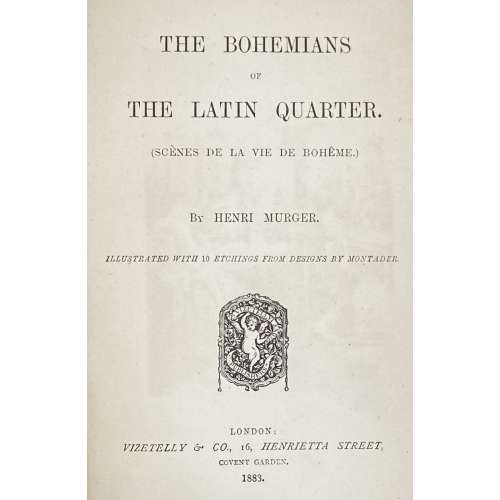 Title: THE BOHEMIANS | OF | THE LATIN QUARTER. | (SCÈNES DE LA VIE DE BOHÊME.) | By HENRI MURGER. | ILLUSTRATED WITH 10 ETCHINGS FROM DESIGNS BY MONTADER. |{publisher’s device}| LONDON: | VIZETELLY & CO., 16, HENRIETTA STREET, | COVENT GARDEN. | 1888. || Pagination: [i-v] vi-xxxiv, [1] 2-317 [318 blank]; collation: 8vo, π1 (h.t.), [a]-b8, B-U8 X7 + 10 etchings by Charles Courtry after Alfred Montader (incl. frontispiece and portrait of Henri Murger). Binding: 23 x 14.5 cm, olive cloth, black lettering to cover and gilt lettering to spine. Contributors: Murger, Henri [Henry] (French, 1822 – 1861) – original text (French). Montader, Pierre Marie Alfred (French, fl. c. 1881 – 1925) – artist. Courtry, Charles Jean Louis (French, 1846 – 1897) – engraver. Vizetelly, Henry Richard (British, 1820 – 1894) – publisher.
Title: THE BOHEMIANS | OF | THE LATIN QUARTER. | (SCÈNES DE LA VIE DE BOHÊME.) | By HENRI MURGER. | ILLUSTRATED WITH 10 ETCHINGS FROM DESIGNS BY MONTADER. |{publisher’s device}| LONDON: | VIZETELLY & CO., 16, HENRIETTA STREET, | COVENT GARDEN. | 1888. || Pagination: [i-v] vi-xxxiv, [1] 2-317 [318 blank]; collation: 8vo, π1 (h.t.), [a]-b8, B-U8 X7 + 10 etchings by Charles Courtry after Alfred Montader (incl. frontispiece and portrait of Henri Murger). Binding: 23 x 14.5 cm, olive cloth, black lettering to cover and gilt lettering to spine. Contributors: Murger, Henri [Henry] (French, 1822 – 1861) – original text (French). Montader, Pierre Marie Alfred (French, fl. c. 1881 – 1925) – artist. Courtry, Charles Jean Louis (French, 1846 – 1897) – engraver. Vizetelly, Henry Richard (British, 1820 – 1894) – publisher. -
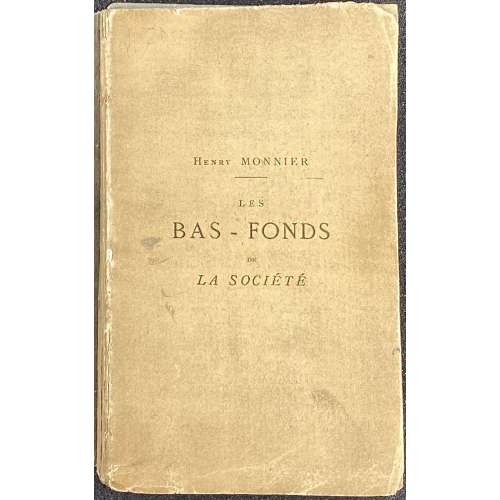 Small softcover volume, ‘édition minuscule’ in-32, 13 x 8 cm, publisher’s wrappers, pp.: [1-6] (h.t., t.p., advert.), [7] 8-160 [2 table/blank], included in pagination 8 pasted etchings on India paper after Félicien Rops and one blank leaf next to plate 1; laid paper with watermarks, some pages uncut. Title-page: DOCUMENTS | POUR SERVIR A L’HISTOIRE DE NOS MŒURS | – | LES | BAS-FONDS | DE LA SOCIÉTÉ | PAR | HENRY MONNIER | AVEC | 8 dessins à la plume | de F. R. | {fleuron} | ÉDITION MINUSCULE | tirée | à 64 exemplaires. || Pencil handwriting on top: 8 gravures de Felicien Rops | 250 –, in the bottom: [1879]. Print run: 64 copies; clandestine edition. Catalogue raisonné: Vicaire V, 1019; Bory p. 100 (though here is the frontispiece for Les Bas-fonds de la société par Joseph Prudhomme [Henry Monnier], 1864, with all the sheets together; Dutel I, A-134. Ref: (1) Poulet-Malassis & ses amis № 90 [LIB-3118.2022] ; (2) Félicien Rops: L'oeuvre graphique complète. / Ouvrage établi et présenté par Jean-François Bory. Avec un texte contemporain de l'artiste par J. K. Huysmans. — Arthur Hubschmidt, 1977. [LIB-2241.2019] Contributors: Henry Monnier (French, 1799 – 1877) – author. Félicien Rops (Belgian, 1833 – 1898) – artist. Henry Kistemaeckers (Belgian, 1851 – 1934) – publisher. Auguste Poulet-Malassis (French, 1825 – 1878)
Small softcover volume, ‘édition minuscule’ in-32, 13 x 8 cm, publisher’s wrappers, pp.: [1-6] (h.t., t.p., advert.), [7] 8-160 [2 table/blank], included in pagination 8 pasted etchings on India paper after Félicien Rops and one blank leaf next to plate 1; laid paper with watermarks, some pages uncut. Title-page: DOCUMENTS | POUR SERVIR A L’HISTOIRE DE NOS MŒURS | – | LES | BAS-FONDS | DE LA SOCIÉTÉ | PAR | HENRY MONNIER | AVEC | 8 dessins à la plume | de F. R. | {fleuron} | ÉDITION MINUSCULE | tirée | à 64 exemplaires. || Pencil handwriting on top: 8 gravures de Felicien Rops | 250 –, in the bottom: [1879]. Print run: 64 copies; clandestine edition. Catalogue raisonné: Vicaire V, 1019; Bory p. 100 (though here is the frontispiece for Les Bas-fonds de la société par Joseph Prudhomme [Henry Monnier], 1864, with all the sheets together; Dutel I, A-134. Ref: (1) Poulet-Malassis & ses amis № 90 [LIB-3118.2022] ; (2) Félicien Rops: L'oeuvre graphique complète. / Ouvrage établi et présenté par Jean-François Bory. Avec un texte contemporain de l'artiste par J. K. Huysmans. — Arthur Hubschmidt, 1977. [LIB-2241.2019] Contributors: Henry Monnier (French, 1799 – 1877) – author. Félicien Rops (Belgian, 1833 – 1898) – artist. Henry Kistemaeckers (Belgian, 1851 – 1934) – publisher. Auguste Poulet-Malassis (French, 1825 – 1878) -
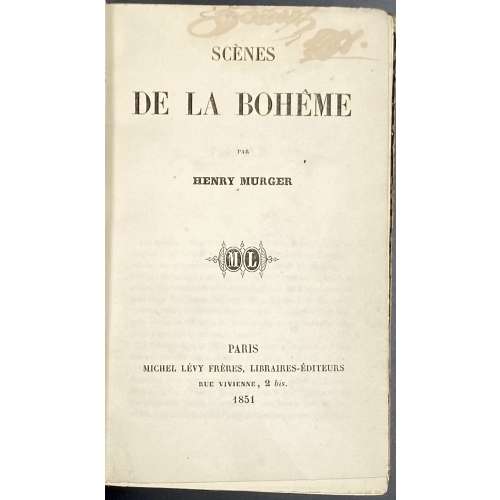 Hardcover volume, 18.2 x 11.8 cm, bound in quarter black polished calf with gilt lettering “cartonnage romantique” design to spine, marbled boards, matching marbled endpapers, blue margins. Title-page: SCÈNES | DE LA BOHÊME | PAR | HENRY MURGER | {publisher’s device ML} | PARIS | MICHEL LÉVY FRÈRES, LIBRAIRES-ÉDITEURS | RUE VIVIENNE, 2 bis. | 1851 || Half-title: ŒUVRES | D’HENRY MURGER || Advertisement: Chez le même Éditeurs. | BIBLIOTHEQUE CONTEMPORAINE | (page of text) || Collation: π2 (h.t/advert., t.p. / blank), 1-33 (17)12, χ6; total 212 leaves without ffls (3 front, 2 back). Pagination: [2] – h.t. / blank, [2] – t.p. / blank, [i] ii-xiii [xiv blank], [1] 2-406; total 424 pages. Scènes de la bohême, in later editions Scènes de la vie de bohème. Translations: Into English: LIB-2719.2021. Henri Murger. The Bohemians of the Latin Quarter. (Scènes de la vie de Bohême) / Translated from the French. — London: Vizetelly & Co., 1883. Into German: LIB-2686.2021. Henri Murger. Die Bohème : Szenen aus dem Pariser Künstlerleben. — Leipzig: Insel-Verlag, 1906. Into Russian: LIB-3182.2023. А. Мюрже. Сцены из жизни богемы / Пер. с франц. и прим. Е. А. Гунста; вст. ст. С. И. Великовского; художник Н. А. Кравченко. — М.: Художественная литература, 1963. Contributors: Murger, Henri [Henry] (French, 1822 – 1861) – author.
Hardcover volume, 18.2 x 11.8 cm, bound in quarter black polished calf with gilt lettering “cartonnage romantique” design to spine, marbled boards, matching marbled endpapers, blue margins. Title-page: SCÈNES | DE LA BOHÊME | PAR | HENRY MURGER | {publisher’s device ML} | PARIS | MICHEL LÉVY FRÈRES, LIBRAIRES-ÉDITEURS | RUE VIVIENNE, 2 bis. | 1851 || Half-title: ŒUVRES | D’HENRY MURGER || Advertisement: Chez le même Éditeurs. | BIBLIOTHEQUE CONTEMPORAINE | (page of text) || Collation: π2 (h.t/advert., t.p. / blank), 1-33 (17)12, χ6; total 212 leaves without ffls (3 front, 2 back). Pagination: [2] – h.t. / blank, [2] – t.p. / blank, [i] ii-xiii [xiv blank], [1] 2-406; total 424 pages. Scènes de la bohême, in later editions Scènes de la vie de bohème. Translations: Into English: LIB-2719.2021. Henri Murger. The Bohemians of the Latin Quarter. (Scènes de la vie de Bohême) / Translated from the French. — London: Vizetelly & Co., 1883. Into German: LIB-2686.2021. Henri Murger. Die Bohème : Szenen aus dem Pariser Künstlerleben. — Leipzig: Insel-Verlag, 1906. Into Russian: LIB-3182.2023. А. Мюрже. Сцены из жизни богемы / Пер. с франц. и прим. Е. А. Гунста; вст. ст. С. И. Великовского; художник Н. А. Кравченко. — М.: Художественная литература, 1963. Contributors: Murger, Henri [Henry] (French, 1822 – 1861) – author. -
 NEWHardcover, 217 x 140 mm, bound in quarter vellum over marbled boards, lettering to spine, collated 8vo: π4 1-108 114 (i.e. 88 leaves), pp.: [i-v] vi-viii, [1] 2-168; to front pastedown armorial bookplate “Bibliothèque de Mr de Barante № ___” and pencil inscription “B-183-F”, to rear pastedown bookseller’s ticket “№ 2683”. Title-page: ÉTUDES | SUR LE | SYSTÈME PÉNITENTIAIRE | ET SUR | SON APPLICATION | AU RÉGIME DES PRISONS DE FRANCE | Par M. H. DIARD | PRÉSIDENT HONORAIRE A LA COUR D'APPEL DE RIOM, OFFICIER DE LA LÉGION | D'HONNEUR ET DE L'INSTRUCTION PUBLIQUE, MEMBRE DE LA SECIÉTÉ D'AGRICULTURE, | SCIENCES, ARTS ET BELLES-LETTRES DU DÉPARTEMENT D'INDRE-ET-LOIRE | — | TOURS | IMPRIMERIE LADEVÈZE | Rue Chaude, 6. | — | 1875 || Provenance: Engraved armorial bookplate of Claude Antoine Prosper Félix Brugière, baron de Barante (French, 1851 – 1925). Author: Charles François Hippolyte Diard (French, 1795 – 1877), président à la cour impériale de Riom, Officier de la Légion d'honneur (12 AUG 1869). Printer/publisher: Imprimerie Rouillé-Ladevèze (1834 - 1910). Seller's note: "Rare first edition, rare in commerce. Proposes reforms for the French prison system based on the study of the methods of America and other European countries, including Ireland and England. With a section on the handling of young offenders and agricultural detention centres, like that at Mettray".
NEWHardcover, 217 x 140 mm, bound in quarter vellum over marbled boards, lettering to spine, collated 8vo: π4 1-108 114 (i.e. 88 leaves), pp.: [i-v] vi-viii, [1] 2-168; to front pastedown armorial bookplate “Bibliothèque de Mr de Barante № ___” and pencil inscription “B-183-F”, to rear pastedown bookseller’s ticket “№ 2683”. Title-page: ÉTUDES | SUR LE | SYSTÈME PÉNITENTIAIRE | ET SUR | SON APPLICATION | AU RÉGIME DES PRISONS DE FRANCE | Par M. H. DIARD | PRÉSIDENT HONORAIRE A LA COUR D'APPEL DE RIOM, OFFICIER DE LA LÉGION | D'HONNEUR ET DE L'INSTRUCTION PUBLIQUE, MEMBRE DE LA SECIÉTÉ D'AGRICULTURE, | SCIENCES, ARTS ET BELLES-LETTRES DU DÉPARTEMENT D'INDRE-ET-LOIRE | — | TOURS | IMPRIMERIE LADEVÈZE | Rue Chaude, 6. | — | 1875 || Provenance: Engraved armorial bookplate of Claude Antoine Prosper Félix Brugière, baron de Barante (French, 1851 – 1925). Author: Charles François Hippolyte Diard (French, 1795 – 1877), président à la cour impériale de Riom, Officier de la Légion d'honneur (12 AUG 1869). Printer/publisher: Imprimerie Rouillé-Ladevèze (1834 - 1910). Seller's note: "Rare first edition, rare in commerce. Proposes reforms for the French prison system based on the study of the methods of America and other European countries, including Ireland and England. With a section on the handling of young offenders and agricultural detention centres, like that at Mettray". -
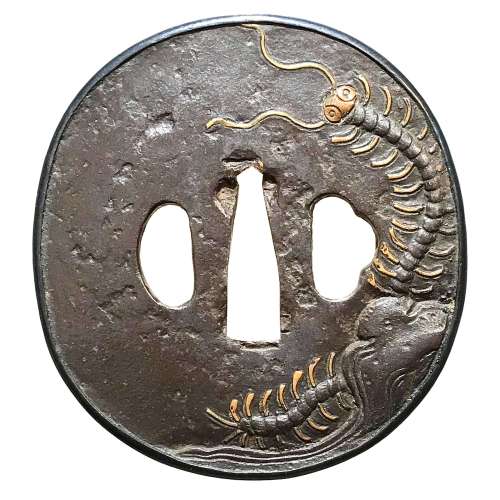
Iron tsuba of oval form with a shakudō fukurin and rough surface decorated by low relief carving and brass inlay with a centipede emerging from under the rock on both sides.
Edo period.Size: 78.9 x 73.6 x 3.8 mm
Unsigned. However, this tsuba may be (though with reservation) attributed to Misumi Kōji school. There is some information regarding this master(s) in Tsuba. An aesthetic study by Kazutaro Torigoye and Robert E. Haynes (from the Tsuba Geijutsu-kō of Kazataro Torigoye. Edited and published by Alan L. Harvie for the Nothern California Japanese Sword Club, 1994-1997) on pages 163-4, though I was not able to locate the tsuba in the original publication. Possibly, this fragment of the book was added by Robert Haynes. Markus Sesko speculates about Misumi in his The Japanese toso-kinko Schools.// Lulu Inc., 2012 on pages 374-5: "Misumi Kōjo Tsuba. Iron plate, elliptical shape, shakudō takabori suemon, yamagane fukurin. Centipede." But of course, visual similarity does not prove anything. I was not able to find any traces of signature or a triangle on the seppa-dai.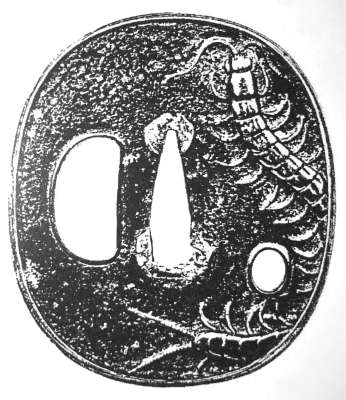
Misumi Kōji Tsuba on p. 163.
-
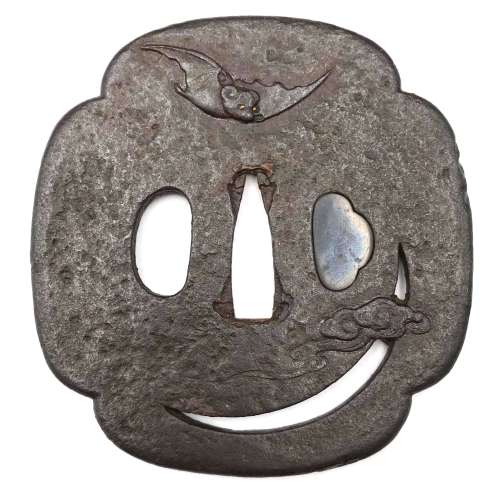
Iron tsuba of mokko form with rough surface decorated in low relief carving (sukidashi-bori) and openwork (sukashi) with a flying bat, a crescent moon, and a cloud over the moon. Bat's eyes inlaid with gold. Crescent moon and cloud on the reverse. Copper sekigane. Kogai hitsu-ana plugged with shakudō.
Unsigned.
Edo period.Size: Height: 83.7 mm; Width: 80.3 mm; Thickness: 2.9 mm; Weight: 141 g.
-
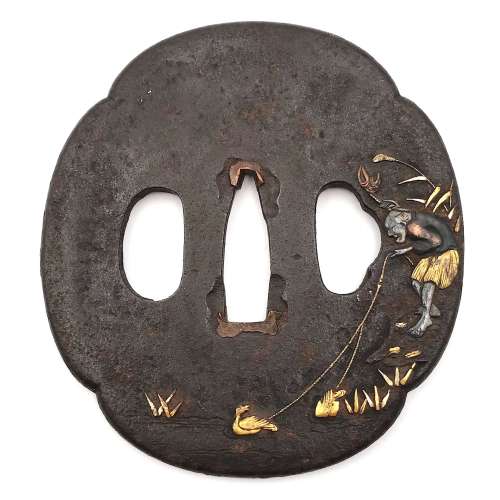 Mokkō form iron tsuba carved in relief and inlaid with soft metals (copper, gold, silver) with the design of a cormorant fisherman on the face and a boat on the reverse. Unsigned. Dimensions: 77 mm x 69 mm x 3.0 mm (at seppa-dai) Edo period: 18th or 19th century. "Since Nara period, Japanese fishermen in small boats have used cormorants (u) to catch river fish at night, binding the necks of the birds so that the fish are not swallowed. [...] The bird and the work it performs are symbols of selfless devotion to one's master and keen eyesight." - from Merrily Baird. Symbols of Japan. Thematic motifs in art and design. Rizzoli international publications, Inc., 2001; p. 104. See also in this collection TSU-0212 and TSU-0241.
Mokkō form iron tsuba carved in relief and inlaid with soft metals (copper, gold, silver) with the design of a cormorant fisherman on the face and a boat on the reverse. Unsigned. Dimensions: 77 mm x 69 mm x 3.0 mm (at seppa-dai) Edo period: 18th or 19th century. "Since Nara period, Japanese fishermen in small boats have used cormorants (u) to catch river fish at night, binding the necks of the birds so that the fish are not swallowed. [...] The bird and the work it performs are symbols of selfless devotion to one's master and keen eyesight." - from Merrily Baird. Symbols of Japan. Thematic motifs in art and design. Rizzoli international publications, Inc., 2001; p. 104. See also in this collection TSU-0212 and TSU-0241. -
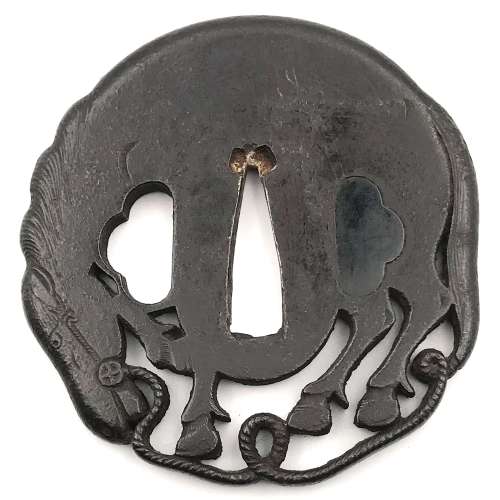
Iron tsuba pierced and carved (marubori-sukashi) with the 'horse in the round' design. Possibly, Bushū-Ito school, 19th century (ca. 1800). Kogai-hitsu-ana plugged with shakudō.
Size: 67.6 x 66.8 x 5.1 mm
Unsigned.
See:
-
- Robert E. Haynes. Study Collection of Japanese Sword Fittings. Nihon Art Publishers, 2010, p. 120: Iron plate carved and formed in the round as a tethered bull...Signed: Bushū jū Sadayasu saku.
- Robert E. Haynes. Masterpiece and highly important tsuba, etc... San Francisco, 1984 // Catalog #9.: Signed: Bushū jū Yoshifusa. Ca. 1800, H 6.7 cm, Th. 4.75 mm.
- The Hartman collection of Japanese metalwork. Christie's, 1976, p. 29, №59: Bushū type, 19th century. Reference to Takezawa, Nihon Toban Zuetsu №411 for a similar design signed Bushū Yoshifusa.
4. Japanese Sword Fittings from the R. B. Caldwell Collection. Sale LN4188 "HIGO". Sotheby's, 30th March 1994, p. 17, №24: An iron tsuba, by Heianjo Sadatsune, Edo period (18th century). In the form of a horse, standing with its head lowered and a rope halter attached to its bit and trailing beneath. Signed Heianjo Sadatsune, 7.3 cm. With NBTHK Tokubetsu kicho paper, dated Showa 49 (1974). GBP 600-700.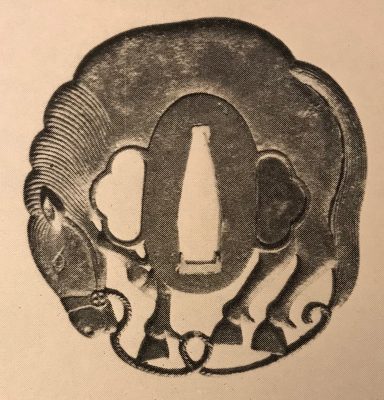
Hartman collection, №59.
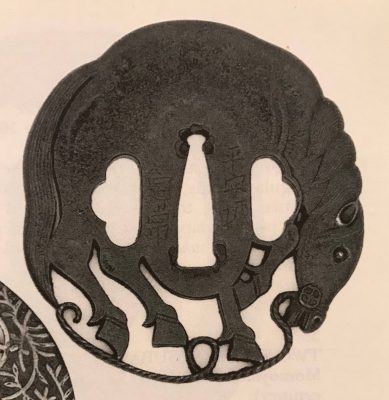
The Caldwell Collection. Heianjo Sadatsune, Edo period (18th century).
-
-
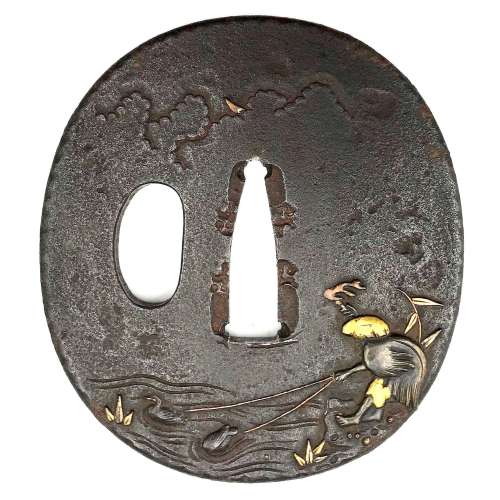 Iron tsuba of oval form carved and inlaid in gold and copper with cormorant fisherman in disguise. Unsigned. Dimensions: 67.7 mm x 61.5 mm x 3.8 mm (at seppa-dai) Edo period: 18th century. "Since Nara period, Japanese fishermen in small boats have used cormorants (u) to catch river fish at night, binding the necks of the birds so that the fish are not swallowed. [...] The bird and the work it performs are symbols of selfless devotion to one's master and keen eyesight." - from Merrily Baird. Symbols of Japan. Thematic motifs in art and design. Rizzoli international publications, Inc., 2001; p. 104. See also TSU-0212 and TSU-0096
Iron tsuba of oval form carved and inlaid in gold and copper with cormorant fisherman in disguise. Unsigned. Dimensions: 67.7 mm x 61.5 mm x 3.8 mm (at seppa-dai) Edo period: 18th century. "Since Nara period, Japanese fishermen in small boats have used cormorants (u) to catch river fish at night, binding the necks of the birds so that the fish are not swallowed. [...] The bird and the work it performs are symbols of selfless devotion to one's master and keen eyesight." - from Merrily Baird. Symbols of Japan. Thematic motifs in art and design. Rizzoli international publications, Inc., 2001; p. 104. See also TSU-0212 and TSU-0096 -
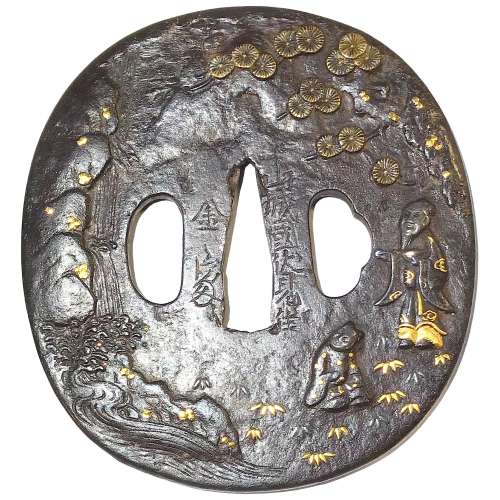
Large oval form tsuba decorated with two human figures (scholar and attendant) under the pine tree admiring a view of a waterfall on the face of the plate, and with stylized dragons carved on the reverse among the symbols of thunder inlaid in gold. The plate is carved in low relief with details inlaid with gold and silver.
Signed: Yamashiro no kuni Fushimi no ju Kaneie [Kaneie of Fushimi in Yamashiro Province] [山城國伏見住金家], with Kaō. It is a fake signature (
gimei). Size: Height: 91.9 mm; Width: 85.6 mm; Thickness: 3.4 mm; Weight: 169 g.
This is a late Edo period, 19th-century export work to cater to the tastes of the European tsuba collectors. It does not have anything in common with the work of great Kaneie masters.
SOLD -
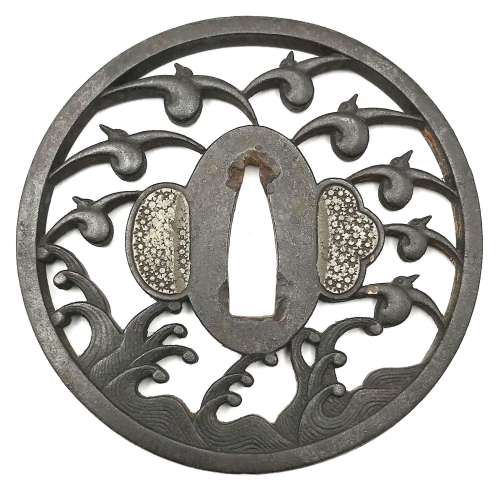
Iron tsuba of circular form with the knotted geese (kari) flying over the rough waves pierced (sukashi) and carved in low relief (nikubori). Hitsu-ana plugged with soft metal. Hitsu-ana plugged with soft metal (tin or lead).
Signed: Echizen koku jū Myochin Katsuharu saku.
Edo period.Size: Height: 80.7 mm; Width: 81.0 mm; Thickness: 4.5 mm; Weight: 110 g.
Two tsuba of this master can be found at Georg Oeder Collection (Japanische Stichblätter und Schwertzieraten. Sammlung Georg Oeder Düsseldorf. Beschreibendes Verzeichnis von P. Vautier. Herausgegeben von Otto Kümmel.Oesterheld & Co / Verlag / Berlin, Oesterheld, 1915; LIB-1465 in this collection) under №№ 172 and 173, page 21, though no illustrations. SOLD.


